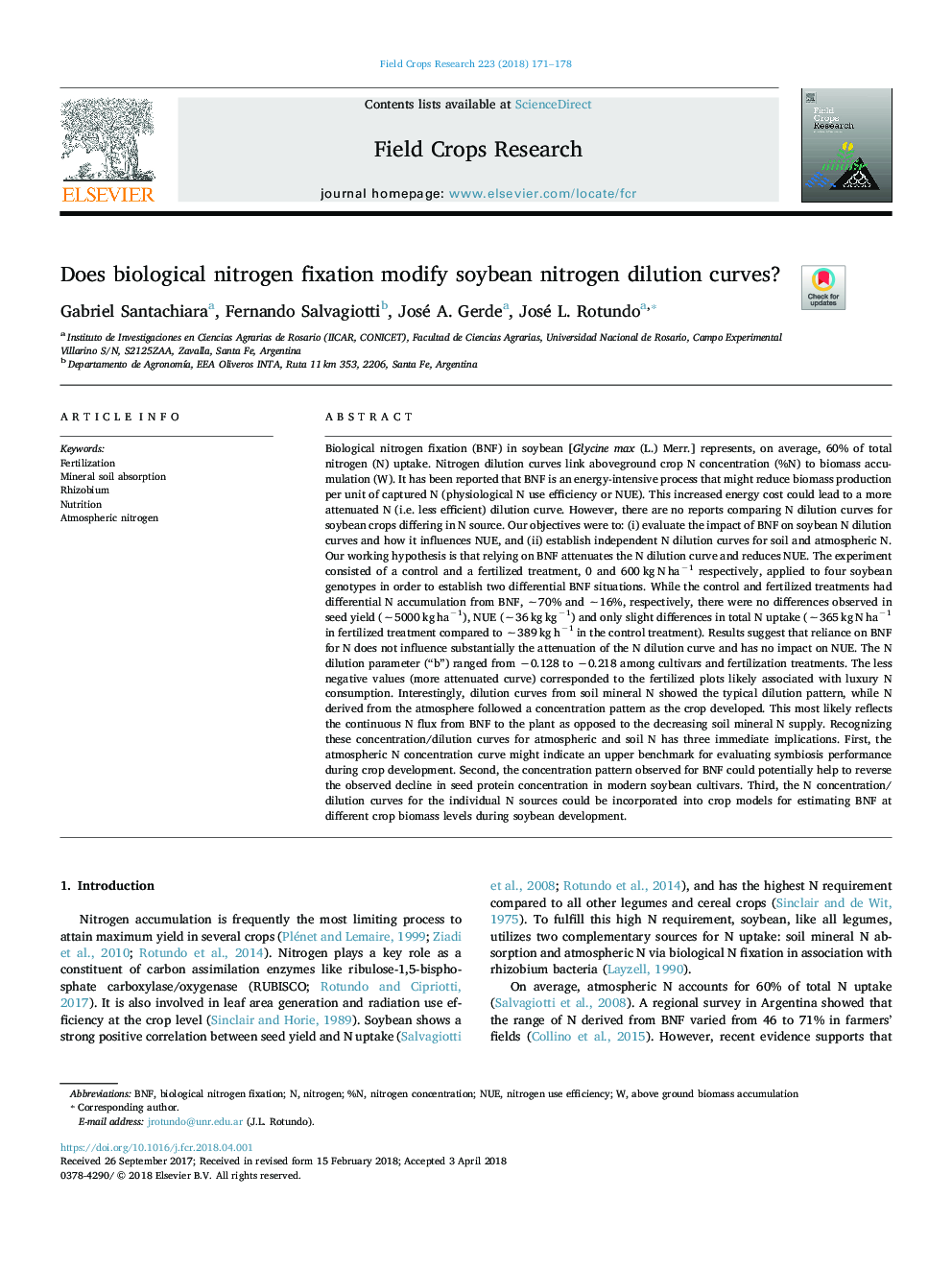| کد مقاله | کد نشریه | سال انتشار | مقاله انگلیسی | نسخه تمام متن |
|---|---|---|---|---|
| 8879167 | 1624640 | 2018 | 8 صفحه PDF | دانلود رایگان |
عنوان انگلیسی مقاله ISI
Does biological nitrogen fixation modify soybean nitrogen dilution curves?
ترجمه فارسی عنوان
آیا اصلاح نیتروژن بیولوژیکی منحنی های رقیق نیتروژن سویا را تغییر می
دانلود مقاله + سفارش ترجمه
دانلود مقاله ISI انگلیسی
رایگان برای ایرانیان
کلمات کلیدی
موضوعات مرتبط
علوم زیستی و بیوفناوری
علوم کشاورزی و بیولوژیک
علوم زراعت و اصلاح نباتات
چکیده انگلیسی
Biological nitrogen fixation (BNF) in soybean [Glycine max (L.) Merr.] represents, on average, 60% of total nitrogen (N) uptake. Nitrogen dilution curves link aboveground crop N concentration (%N) to biomass accumulation (W). It has been reported that BNF is an energy-intensive process that might reduce biomass production per unit of captured N (physiological N use efficiency or NUE). This increased energy cost could lead to a more attenuated N (i.e. less efficient) dilution curve. However, there are no reports comparing N dilution curves for soybean crops differing in N source. Our objectives were to: (i) evaluate the impact of BNF on soybean N dilution curves and how it influences NUE, and (ii) establish independent N dilution curves for soil and atmospheric N. Our working hypothesis is that relying on BNF attenuates the N dilution curve and reduces NUE. The experiment consisted of a control and a fertilized treatment, 0 and 600â¯kgâ¯Nâ¯haâ1 respectively, applied to four soybean genotypes in order to establish two differential BNF situations. While the control and fertilized treatments had differential N accumulation from BNF, â¼70% and â¼16%, respectively, there were no differences observed in seed yield (â¼5000â¯kgâ¯haâ1), NUE (â¼36â¯kgâ¯kgâ1) and only slight differences in total N uptake (â¼365â¯kgâ¯Nâ¯haâ1 in fertilized treatment compared to â¼389â¯kgâ¯hâ1 in the control treatment). Results suggest that reliance on BNF for N does not influence substantially the attenuation of the N dilution curve and has no impact on NUE. The N dilution parameter (“b”) ranged from â0.128 to â0.218 among cultivars and fertilization treatments. The less negative values (more attenuated curve) corresponded to the fertilized plots likely associated with luxury N consumption. Interestingly, dilution curves from soil mineral N showed the typical dilution pattern, while N derived from the atmosphere followed a concentration pattern as the crop developed. This most likely reflects the continuous N flux from BNF to the plant as opposed to the decreasing soil mineral N supply. Recognizing these concentration/dilution curves for atmospheric and soil N has three immediate implications. First, the atmospheric N concentration curve might indicate an upper benchmark for evaluating symbiosis performance during crop development. Second, the concentration pattern observed for BNF could potentially help to reverse the observed decline in seed protein concentration in modern soybean cultivars. Third, the N concentration/dilution curves for the individual N sources could be incorporated into crop models for estimating BNF at different crop biomass levels during soybean development.
ناشر
Database: Elsevier - ScienceDirect (ساینس دایرکت)
Journal: Field Crops Research - Volume 223, 15 June 2018, Pages 171-178
Journal: Field Crops Research - Volume 223, 15 June 2018, Pages 171-178
نویسندگان
Gabriel Santachiara, Fernando Salvagiotti, José A. Gerde, José L. Rotundo,
